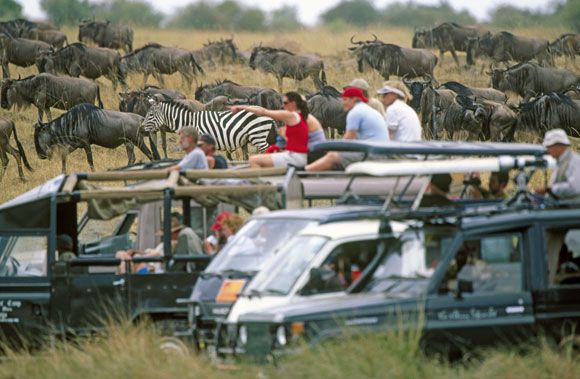No one knows how, exactly, but wildebeest – a scruffy-looking creature with a head like a bison and the body of a gazelle – can sense rain at a distance of hundreds of kilometres. These herbivores, also known as gnus, are doomed to wander their native Africa in constant search of fresh grazing, and each year they take part in the last great wildlife migration on the planet.
There is no real beginning or end to the circular movement of the herds, and it keeps to no calendar schedule; the driving force is simply a survival reflex that leads the nomadic animals to make the journey of over 3,000 kilometres through Kenya and Tanzania, ignoring boundaries established by the white man in the days of colonisation, following their natural instinct.
When water becomes scarce in the plains of the Serengeti, usually in early months of the year, the animals gather from all over the vast Tanzanian park and head en masse towards the rains in Kenya's Maasai Mara reserve in the north. Around one and a half million wildebeest, accompanied by some 250,000 Burchell's zebras and half a million Thomson's gazelles, reach the Maasai Mara, having run the gauntlet of crocodiles, big cats and other predators.
Their journey takes them across rivers – the Grumeti in Tanzania, the Talek and Mara in Kenya – where the herds gather on the banks looking for the best place and waiting for the safest moment to ford the waters. When one animal decides the moment has come and plunges into the water, the rest follow in single file. Dawdlers are trampled by their peers and the slightest hint of danger will cause a stampede where many others will die.
During the migration, some quarter of a million animals fall by the wayside each year, but instinct forces the herd to move on. Some die of exhaustion, others are swept away by the rivers, or fall prey to crocodiles. These, and other predators such as lions, leopards, cheetahs and hyenas, follow with great interest the movements of this vast supply of fresh meat, watching for a chance to take out the young, the sick, or any stragglers that get separated from the herd. Marabou storks, vultures and other carrion birds and scavengers watch and wait their turn, hoping for a share of the spoils.
The female wildebeest usually give birth in the Serengeti grasslands between January and March, and almost before the calves' legs are strong enough for them to keep up, they leave the parched plains on their way to the dappled scrub and savannah of Maasai Mara, only to return in the autumn in this eternal procession, a cyclic journey that ends only with death.
The migration can be witnessed in different parts of the Serengeti and the Maasai Mara at different times of the year but is dependent on weather and other unpredictable natural conditions and there are no exact dates or route. If you want to see the most spectacular moments, such as when the vast herds ford a river, your best bet is to contact an agency that specialise in safaris in East Africa. Some websites such as Ultimate Africa Safaris post updates of the progress of the migration on-line.














